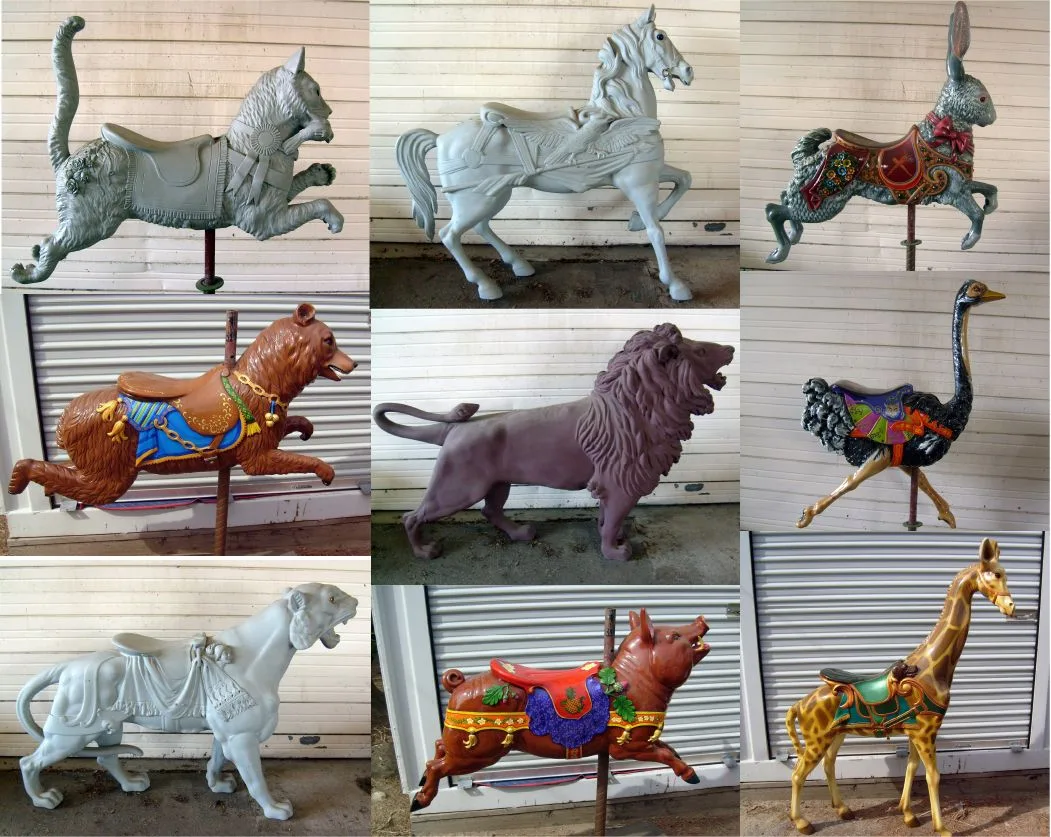Introduction
Fiberglass animal molds have become increasingly popular in various industries, from theme parks and zoos to art installations and garden décor. Their versatility, durability, and lightweight nature make them ideal for creating realistic and intricate animal sculptures. But how do you choose the right fiberglass animal mold for your needs? In this guide, we’ll explore everything you need to know about fiberglass animal molds, including their benefits, how they’re made, and tips for selecting and using them effectively.

fiberglass animal molds
What Are Fiberglass Animal Molds?
Fiberglass animal molds are sculptural forms used to create replicas of animals in various sizes and shapes. These molds are crafted using fiberglass, a strong, lightweight material made from fine fibers of glass. They are widely utilized in multiple sectors, including entertainment, art, advertising, and landscaping. Due to their ability to replicate the intricate details of animal forms, fiberglass animal molds are essential for producing high-quality sculptures that can withstand the elements while maintaining their aesthetic appeal.
Benefits of Fiberglass Animal Molds
Fiberglass animal molds offer several advantages over other materials such as metal, clay, or resin:
- Durability and Longevity: Fiberglass is known for its strength and resistance to weathering, UV rays, and corrosion. This makes it ideal for outdoor installations where the sculpture will be exposed to various environmental conditions.
- Lightweight and Easy to Handle: Despite their strength, fiberglass molds are relatively lightweight, making them easier to transport and handle during the production process.
- Cost-Effectiveness: Fiberglass is generally more affordable than other materials, especially for large-scale projects, which helps reduce overall production costs without compromising on quality.
How Fiberglass Animal Molds Are Made
The production of fiberglass animal molds involves several key steps:
- Designing the Mold: A model or prototype of the desired animal sculpture is created, often using 3D modeling software or handcrafted methods. This model serves as the foundation for creating the mold.
- Applying the Fiberglass Layers: A gel coat is applied to the model to form a smooth outer surface. Layers of fiberglass mat and resin are then applied to build up the mold’s thickness and strength. The resin binds the fiberglass layers together, creating a solid structure.
- Curing and Finishing: The mold is left to cure and harden, ensuring it maintains its shape and durability. After curing, the mold is sanded and polished to achieve a smooth finish. This step is crucial to prevent any imperfections from transferring to the final product.
Tips for Choosing the Right Fiberglass Animal Mold
When selecting a fiberglass animal mold, consider the following factors:
- Size and Scale: Ensure the mold is appropriately sized for your project. For large outdoor sculptures, you may need a more robust mold, while smaller projects might require a more detailed one.
- Quality and Detail: Look for molds with high-quality craftsmanship and intricate details that accurately capture the animal’s features. The finer the details, the more realistic the final sculpture will appear.
- Reputable Manufacturers: Choose manufacturers with a proven track record in producing durable and well-crafted fiberglass molds. Research reviews and testimonials to ensure you are investing in a reliable product.
How to Use and Maintain Fiberglass Animal Molds
Using fiberglass animal molds effectively requires a few simple steps:
- Prepare the Mold: Clean the mold thoroughly to remove any dust or debris. This step is essential for ensuring a smooth casting surface and preventing defects in the final product.
- Apply a Release Agent: Use a release agent to prevent the material from sticking to the mold during casting. This agent forms a barrier between the mold and the casting material, making it easier to remove the final sculpture.
- Cast the Sculpture: Pour or lay the chosen material (such as concrete or resin) into the mold, ensuring it fills all the details. Use tools to eliminate air bubbles and ensure even distribution of the material.
- Demold Carefully: Once the material has set, carefully remove the sculpture from the mold to avoid damaging it. Use proper techniques to separate the mold without causing cracks or breaks in the sculpture.
Maintenance Tips to Prolong the Mold’s Lifespan
To maintain your fiberglass animal mold:
- Regular Cleaning: After each use, clean the mold with mild soap and water to remove residue. Avoid using abrasive cleaners that could damage the mold’s surface.
- Proper Storage: Store molds in a cool, dry place away from direct sunlight to prevent warping or damage. Extreme temperatures can cause fiberglass to degrade over time.
- Routine Inspections: Periodically inspect molds for any signs of wear or damage and repair them promptly to extend their lifespan. Look for cracks, chips, or areas where the fiberglass has thinned out.
Conclusion
Fiberglass animal molds offer a versatile and cost-effective solution for creating detailed animal sculptures for various applications. By understanding the benefits of fiberglass molds, how they are made, and how to choose and maintain them, you can ensure successful and long-lasting results for your projects. Ready to start your next creative endeavor? Explore the wide range of fiberglass animal molds available today and bring your ideas to life!




























